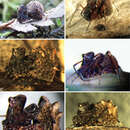Zephyrarchaea barrettae: Brief Summary
provided by wikipedia EN
Zephyrarchaea barrettae is a species of spider of the family Archaeidae. The Latin species name was chosen to honor Sarah Barrett, who first discovered assassin spiders in the Stirling Range National Park.
- license
- cc-by-sa-3.0
- copyright
- Wikipedia authors and editors
Description
provided by Zookeys
Holotype male: Total length 3.13; leg I femur 2.19; F1/CL ratio 1.92. Cephalothorax dark reddish-brown; legs tan brown with darker annulations; abdomen mottled grey-brown and beige, with reddish-brown dorsal scute and sclerites (Fig. 15B). Carapace relatively short (CH/CL ratio 1.71); 1.14 long, 1.95 high, 1.13 wide; ‘neck’ 0.67 wide; highest point of pars cephalica (HPC) approaching posterior third of ‘head’ (ratio of HPC to post-ocular length 0.59), carapace with shallow concave depression anterior to HPC; ‘head’ not strongly elevated dorsally (post-ocular ratio 0.21) (Fig. 8F). Chelicerae with proximal brush and additional comb of accessory setae on anterior face of paturon (Fig. 15C). Abdomen 1.59 long, 1.21 wide; almost spherical in lateral profile, without dorsal hump-like tubercles; dorsal scute fused anteriorly to epigastric sclerites, extending posteriorly to cover anterior two-thirds of dorsal abdomen. Unexpanded pedipalp (Figs 15D–F) pyriform, with broad, distally curved embolus supported by conductor sclerites 1–2; tegular sclerite 1 (TS 1) strongly curved, claw-like in prolateral view, with twisted, flattened and broadly rounded apex; TS 2–3 not projecting beyond retro-distal rim of tegulum.
Allotype female: Total length 3.64; leg I femur 2.31; F1/CL ratio 1.77. Cephalothorax dark reddish-brown; legs tan brown with darker annulations; abdomen variably beige-grey (Fig. 15A). Carapace relatively short (CH/CL ratio 1.78); 1.31 long, 2.33 high, 1.26 wide; ‘neck’ 0.78 wide; highest point of pars cephalica (HPC) approaching posterior third of ‘head’ (ratio of HPC to post-ocular length 0.59), carapace with shallow concave depression anterior to HPC; ‘head’ not strongly elevated dorsally (post-ocular ratio 0.22) (Fig. 9I). Chelicerae without accessory setae on anterior face of paturon. Abdomen 1.90 long, 1.69 wide; spherical in lateral profile, without dorsal hump-like tubercles. Internal genitalia (Fig. 15G) with cluster of ≤ 15 sausage-shaped spermathecae either side of gonopore, clusters widely separated along midline of genital plate.
- license
- cc-by-3.0
- copyright
- Michael G. Rix, Mark S. Harvey
- bibliographic citation
- Rix M, Harvey M (2012) Australian Assassins, Part II: A review of the new assassin spider genus Zephyrarchaea (Araneae, Archaeidae) from southern Australia ZooKeys 191: 1–62
- author
- Michael G. Rix
- author
- Mark S. Harvey
Distribution
provided by Zookeys
Zephyrarchaea barrettae is known only from the summit of Talyuberlup Peak, in the western Stirling Range National Park of southern Western Australia (west of Chester Pass) (Fig. 25). Specimens have been collected by beating and sifting sedges (Lepidosperma sp.) in montane heathland.
- license
- cc-by-3.0
- copyright
- Michael G. Rix, Mark S. Harvey
- bibliographic citation
- Rix M, Harvey M (2012) Australian Assassins, Part II: A review of the new assassin spider genus Zephyrarchaea (Araneae, Archaeidae) from southern Australia ZooKeys 191: 1–62
- author
- Michael G. Rix
- author
- Mark S. Harvey

